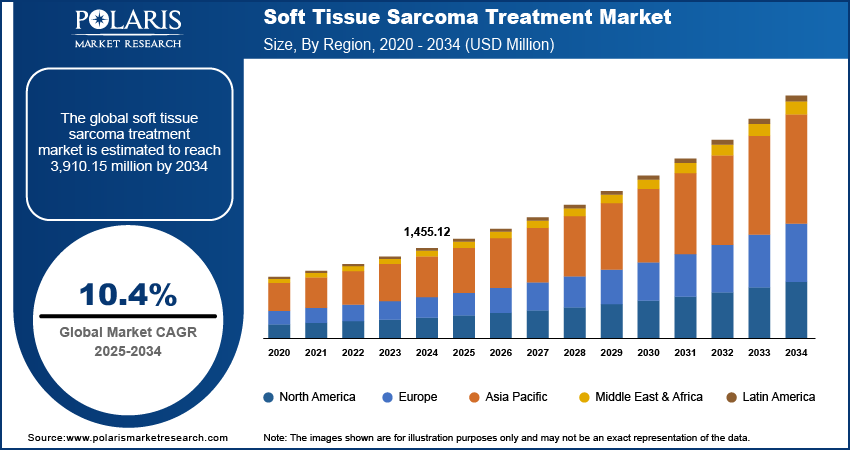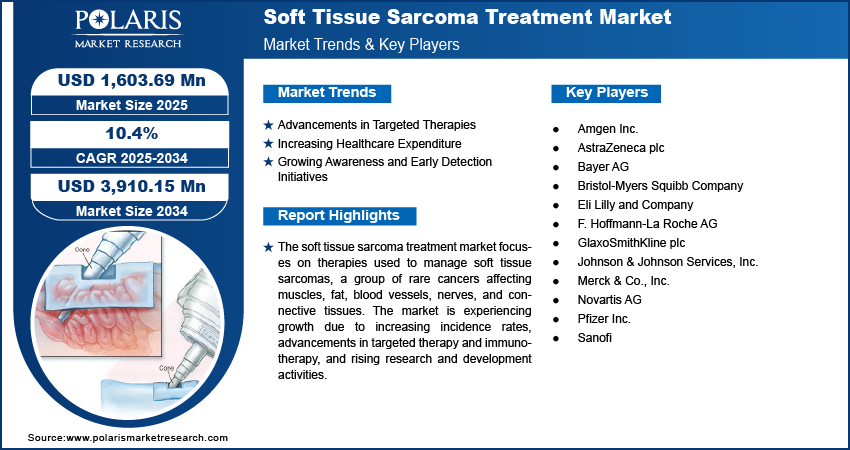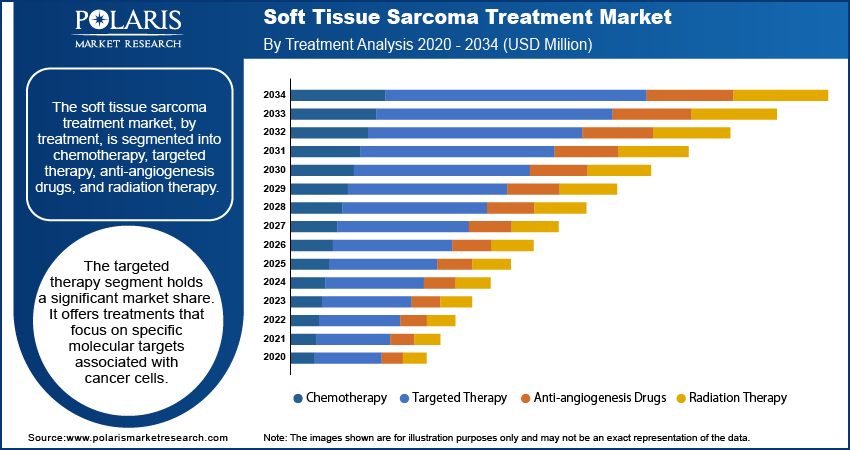
Soft Tissue Sarcoma Treatment Market Size, Share, Trends, Industry Analysis Report
: By Treatment (Chemotherapy, Targeted Therapy, Anti-angiogenesis Drugs, and Radiation Therapy), Indication, Distribution Channel, End Use, and Region (North America, Europe, Asia Pacific, Latin America, and Middle East & Africa) – Market Forecast, 2025–2034
- Published Date:May-2025
- Pages: 120
- Format: PDF
- Report ID: PM1620
- Base Year: 2024
- Historical Data: 2020-2023
Soft Tissue Sarcoma Treatment Market Overview
The soft tissue sarcoma treatment market size was valued at USD 1,455.12 million in 2024. The market is projected to grow from USD 1,603.69 million in 2025 to USD 3,910.15 million by 2034, exhibiting a CAGR of 10.4% during 2025–2034.
The soft tissue sarcoma treatment market growth is driven by the increasing prevalence of soft tissue sarcomas, advancements in targeted therapies, and rising investments in cancer research. The growing adoption of immunotherapy and precision medicine is significantly influencing treatment approaches. Key trends include the development of novel drug combinations, the expansion of clinical trials for advanced therapies, and the increasing use of artificial intelligence in oncology for improved diagnosis and treatment planning. Additionally, regulatory approvals for innovative treatment options and the rising demand for personalized medicine are shaping soft tissue sarcoma treatment market trends.

To Understand More About this Research: Request a Free Sample Report
Soft Tissue Sarcoma Treatment Market Dynamics
Advancements in Targeted Therapies
The development of targeted therapies has significantly influenced the soft tissue sarcoma treatment market development. These therapies focus on specific molecular alterations within cancer cells, enhancing treatment efficacy while minimizing adverse effects. For instance, the approval of drugs such as pazopanib has provided new options for patients suffering from advanced soft tissue sarcomas.
Increasing Healthcare Expenditure
Rising healthcare expenditure has facilitated greater investments in cancer research and the development of innovative treatments for soft tissue sarcoma. Enhanced funding supports advancements in understanding the disease and the creation of novel therapeutic approaches. For example, India's public healthcare spending reached 2.1% of its GDP in 2021–22, reflecting a commitment to improving healthcare infrastructure and research. Thus, increasing healthcare expenditure boosts the soft tissue sarcoma treatment market growth.
Growing Awareness and Early Detection Initiatives
Increased awareness and early detection initiatives have contributed to the identification of soft tissue sarcomas at more treatable stages. Educational campaigns and improved diagnostic tools enable earlier diagnosis, which is crucial for effective treatment. Organizations such as Sarcoma UK have developed online training resources to aid healthcare professionals in better recognizing and diagnosing sarcoma, contributing to early detection and treatment.

Soft Tissue Sarcoma Treatment Market Segment Insights
Soft Tissue Sarcoma Treatment Market Assessment – Treatment-Based Insights
The soft tissue sarcoma treatment market, by treatment, is segmented into chemotherapy, targeted therapy, anti-angiogenesis drugs, and radiation therapy. The targeted therapy segment has emerged as a significant segment, offering treatments that focus on specific molecular targets associated with cancer cells. This approach aims to inhibit cancer cell growth while minimizing damage to normal tissues. The adoption of targeted therapies has been driven by their potential for increased efficacy and reduced side effects compared to traditional treatments. The development of drugs such as pazopanib has provided new options for patients suffering from advanced soft tissue sarcomas.
Chemotherapy remains a cornerstone in the treatment of soft tissue sarcomas, utilizing cytotoxic drugs to destroy rapidly dividing cancer cells. Despite the emergence of newer therapies, chemotherapy continues to be widely used, particularly in cases where surgery is not feasible or as an adjunct to surgical interventions. Its established protocols and effectiveness in shrinking tumors before surgery or controlling metastatic disease contribute to its sustained utilization in clinical practice.
Soft Tissue Sarcoma Treatment Market Outlook – Indication-Based Insights
The soft tissue sarcoma treatment market, by indication, is segmented into regional, local, and metastatic sarcoma. The local sarcoma segment holds a significant share of the soft tissue sarcoma treatment market revenue in 2024. Local sarcomas are tumors confined to their site of origin without regional or distant spread. The focus on early detection and intervention has led to a higher diagnosis rate of localized tumors, contributing to the prominence of this segment.
The emphasis on early diagnosis and treatment of local sarcomas has been instrumental in improving patient outcomes. Advancements in diagnostic imaging and increased awareness among healthcare professionals have facilitated the identification of these tumors at an earlier, more treatable stage. This trend underscores the importance of continued investment in early detection initiatives to maintain and enhance the management of local soft tissue sarcomas.
Soft Tissue Sarcoma Treatment Market Evaluation – Distribution Channel-Based Insights
The soft tissue sarcoma treatment market, by distribution channel, is segmented into online pharmacy, retail pharmacy, and others. The online pharmacy segment is experiencing notable growth within the soft tissue sarcoma treatment market. This expansion is driven by the increasing adoption of digital health platforms and the convenience they offer to patients. Online pharmacies provide easy access to medications, home delivery services, and often competitive pricing, making them an attractive option for patients managing long-term treatment regimens. As digital healthcare infrastructure continues to advance, the utilization of online pharmacies for procuring cancer treatments is expected to rise, contributing to the overall growth of this distribution channel.

Soft Tissue Sarcoma Treatment Market Evaluation – End Use-Based Insights
The soft tissue sarcoma treatment market, by end use, is segmented into hospitals, homecare, and others. The hospitals segment dominates the soft tissue sarcoma treatment market share. The segment accounts for a substantial share of treatment administration. This is due to the complex nature of soft tissue sarcoma therapies, which often require specialized medical equipment and multidisciplinary teams available in hospital settings. Hospitals are equipped to provide comprehensive care, including surgery, chemotherapy, and radiation therapy, ensuring that patients receive coordinated and effective treatment plans.
The homecare segment is experiencing notable growth, driven by advancements in medical technology and a growing preference for at-home care among patients. Innovations such as portable infusion devices and telemedicine consultations have made it feasible for certain treatments to be administered in the home environment. This approach offers increased comfort and convenience for patients, potentially improving adherence to treatment regimens and overall quality of life. As healthcare systems continue to evolve, the integration of homecare services in the management of soft tissue sarcoma is expected to expand, contributing to the diversification of treatment delivery models.
Soft Tissue Sarcoma Treatment Market – Regional Insights
By region, the study provides soft tissue sarcoma treatment market insights into North America, Europe, Asia Pacific, Latin America, and the Middle East & Africa. In 2024, North America holds the largest market share due to well-established healthcare infrastructure, high adoption of advanced therapies, and strong regulatory support for new drug approvals. The presence of major pharmaceutical companies, ongoing clinical trials, and favorable reimbursement policies further contribute to market growth in the region. Additionally, increasing awareness about early diagnosis and the availability of advanced treatment options drive demand. Europe follows closely, supported by government funding for cancer research and improved access to innovative therapies. Meanwhile, Asia Pacific is emerging as the fastest-growing market due to improving healthcare systems, rising cancer incidence, and increasing adoption of targeted therapies and immunotherapies.
The soft tissue sarcoma treatment market expansion in Europe is driven by strong government support for cancer research, favorable reimbursement policies, and increasing adoption of advanced therapies. Countries such as Germany, the UK, and France have well-developed healthcare systems that facilitate access to innovative treatments, including targeted therapies and immunotherapies. Ongoing clinical trials and collaborations between pharmaceutical companies and research institutions further contribute to market growth. Additionally, rising awareness campaigns and early diagnosis initiatives are improving patient outcomes and boosting the demand for effective treatment options.
The Asia Pacific soft tissue sarcoma treatment market is witnessing significant growth due to improving healthcare infrastructure, increasing cancer prevalence, and growing investments in pharmaceutical research. Countries such as China, India, and Japan are at the forefront, driven by expanding healthcare access and rising adoption of targeted therapies. Government initiatives to enhance cancer care, along with increasing clinical trial activities, are accelerating market expansion. Additionally, the presence of a large patient population and the rising affordability of advanced treatments would contribute to the soft tissue sarcoma treatment market opportunities in the region during the forecast period.

Soft Tissue Sarcoma Treatment Market – Key Players and Competitive Insights
In the soft tissue sarcoma treatment market, several pharmaceutical companies are actively involved in developing and providing therapies. Notable among these are Amgen Inc.; AstraZeneca plc; Bayer AG; Bristol-Myers Squibb Company; Eli Lilly and Company; F. Hoffmann-La Roche AG; GlaxoSmithKline plc; Johnson & Johnson Services, Inc.; Merck & Co., Inc.; Novartis AG; Pfizer Inc.; and Sanofi. These companies have established a significant presence in the market through their ongoing research and development efforts.
Companies such as Sanofi, and Amgen Inc. are contributing to the advancement of soft tissue sarcoma treatments. Their involvement ranges from developing novel therapeutic agents to enhancing existing treatment protocols, thereby enriching the therapeutic landscape for this challenging disease.
The competitive landscape is characterized by continuous innovation, with these companies investing in clinical trials and seeking regulatory approvals for new drugs and treatment modalities. Collaborations and partnerships among these firms further drive progress, aiming to improve patient outcomes and expand the range of effective treatment options available for soft tissue sarcoma.
Pfizer Inc. is a prominent pharmaceutical company engaged in the development and distribution of treatments for various cancers, including soft tissue sarcomas. The company focuses on advancing targeted therapies and immunotherapies to improve patient outcomes in oncology.
Eli Lilly and Company is another key player in the oncology sector, actively involved in researching and developing treatments for soft tissue sarcomas. The company has been working on innovative therapeutic approaches to address the challenges associated with these cancers.
List of Key Companies in Soft Tissue Sarcoma Treatment Market
- Amgen Inc.
- AstraZeneca plc
- Bayer AG
- Bristol-Myers Squibb Company
- Eli Lilly and Company
- F. Hoffmann-La Roche AG
- GlaxoSmithKline plc
- Johnson & Johnson Services, Inc.
- Merck & Co., Inc.
- Novartis AG
- Pfizer Inc.
- Sanofi
Soft Tissue Sarcoma Treatment Industry Developments
- August 2024: Intensity Therapeutics, Inc. announced the dosing of the first patient in its Phase 3 clinical trial (INVINCIBLE 3) evaluating INT230-6 as a second or third-line monotherapy for soft tissue sarcoma. The study aims to compare INT230-6 to standard care, with overall survival as the primary endpoint, marking a significant advancement in potential treatment options for this patient population.
- November 2023: US Food and Drug Administration (FDA) granted orphan drug designation to tigilanol tiglate, developed by QBiotics Group Limited, for the treatment of patients suffering from soft tissue sarcoma.
Soft Tissue Sarcoma Treatment Market Segmentation
By Treatment Outlook (Revenue – USD Million, 2020–2034)
- Chemotherapy
- Targeted Therapy
- Anti-angiogenesis Drugs
- Radiation Therapy
By Indication Outlook (Revenue – USD Million, 2020–2034)
- Regional
- Local
- Metastatic Sarcoma
By Distribution Channel Outlook (Revenue – USD Million, 2020–2034)
- Online Pharmacy
- Retail Pharmacy
- Others
By End Use Outlook (Revenue – USD Million, 2020–2034)
- Hospitals
- Homecare
- Others
By Regional Outlook (Revenue – USD Million, 2020–2034)
- North America
- US
- Canada
- Europe
- Germany
- France
- UK
- Italy
- Spain
- Netherlands
- Russia
- Rest of Europe
- Asia Pacific
- China
- Japan
- India
- Malaysia
- South Korea
- Indonesia
- Australia
- Vietnam
- Rest of Asia Pacific
- Middle East & Africa
- Saudi Arabia
- UAE
- Israel
- South Africa
- Rest of Middle East & Africa
- Latin America
- Mexico
- Brazil
- Argentina
- Rest of Latin America
Soft Tissue Sarcoma Treatment Market Report Scope
|
Report Attributes |
Details |
|
Market Size Value in 2024 |
USD 1,455.12 million |
|
Market Size Value in 2025 |
USD 1,603.69 million |
|
Revenue Forecast by 2034 |
USD 3,910.15 million |
|
CAGR |
10.4% from 2025 to 2034 |
|
Base Year |
2024 |
|
Historical Data |
2020–2023 |
|
Forecast Period |
2025–2034 |
|
Quantitative Units |
Revenue in USD million and CAGR from 2025 to 2034 |
|
Report Coverage |
Revenue Forecast, Market Competitive Landscape, Growth Factors, and Trends |
|
Segments Covered |
|
|
Regional Scope |
|
|
Competitive Landscape |
|
|
Report Format |
|
|
Customization |
Report customization as per your requirements with respect to countries, regions, and segmentation. |
FAQ's
The soft tissue sarcoma treatment market size was valued at USD 1,455.12 million in 2024 and is projected to grow to USD 3,910.15 million by 2034.
The market is projected to register a CAGR of 10.4% during the forecast period.
North America held the largest share of the market due to well-established healthcare infrastructure, high adoption of advanced therapies, and strong regulatory support for new drug approvals.
A few notable market players are Amgen Inc.; AstraZeneca plc; Bayer AG; Bristol-Myers Squibb Company; Eli Lilly and Company; F. Hoffmann-La Roche AG; GlaxoSmithKline plc; Johnson & Johnson Services, Inc.; Merck & Co., Inc.; Novartis AG; Pfizer Inc.; and Sanofi.
The targeted therapy segment accounted for the largest share of the market in 2024 due to its focus on specific molecular targets associated with cancer cells.
The localized soft tissue sarcoma segment accounted for the largest share of the market in 2024.
Soft tissue sarcoma treatment refers to the medical interventions used to manage and treat soft tissue sarcomas, which are rare cancers that develop in the soft tissues of the body, including muscles, fat, blood vessels, nerves, and tendons. Treatment options depend on the type, location, and stage of the sarcoma and may include surgery, radiation therapy, chemotherapy, targeted therapy, and immunotherapy. Surgery is often the primary approach to remove the tumor, while radiation and chemotherapy may be used to shrink tumors before surgery or eliminate remaining cancer cells. Targeted therapies and immunotherapies are emerging as advanced treatment options, focusing on specific cancer cell mechanisms to improve patient outcomes.
A few key trends in the market are described below:
